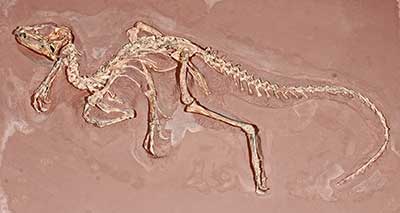Heterodontosaurus
(HET-uh-roh-DONT-oh-SAW-rus)
| Quick Facts | |
|---|---|
| Name Meaning: | Different Teeth Lizard |
| Distribution: | South Africa |
| Time Period: | Early Jurassic, 208-200 Ma |
| Length: | 4 ft (1.2 m) |
| Weight: | 40 lb (20 kg) |
| Diet: | Leaves, Insects |
| Habitat: | Scrubs |
| Linnaean Classification | |
| Kingdom: | Animalia |
| Phylum: | Chordata |
| Class: | Reptilia |
| Superorder: | Dinosauria |
| Order: | Ornithischia |
| Family: | Heterodontosauridae |
| Genus: | Heterodontosaurus |
| Cladistic Classification | |
| |

History
The Heterodontosaurus was first discovered in 1962 and was described by Crompton and Charig. However, only the head was discovered. In 1976 a full skeleton was discovered and is considered to be one of the best-preserved skeletons yet found. It had the look of a Heterodontosaurus in action, as if it died on the move.Description
The Heterodontosaurus was a very small dinosaur with a maximum length of four feet and was a diverse dinosaur in many ways. The most distinguishing feature was its teeth, aptly represented in its name meaning, “different teeth lizard.” While most dinosaurs have one type of tooth the Heterodontosaurus had three. In the front were sharp teeth, followed by canine tusks, with chisel-like grinding teeth in the back. The hands were also unique due to the fact that it had 5 fingers two of which may have been opposable.Lifestyle
The Heterodontosaurus may have used its front sharp teeth as a way of cutting plants or leaves making them easier to process. It is uncertain what the tusks could have been used for. They may have been a defense or possibly a way of competing with other Heterodontosaurus for the right to a mate. The back teeth were used for chewing. The diversity of the teeth has led some to believe that it may have also eaten small animals like insects. The opposable fingers would have allowed it to grasp its prey and would have been useful in capturing small animals.
ScienceViews Writer: Jason Hamilton.
Copyright © 2005-2010 Calvin & Rosanna Hamilton. All rights reserved.